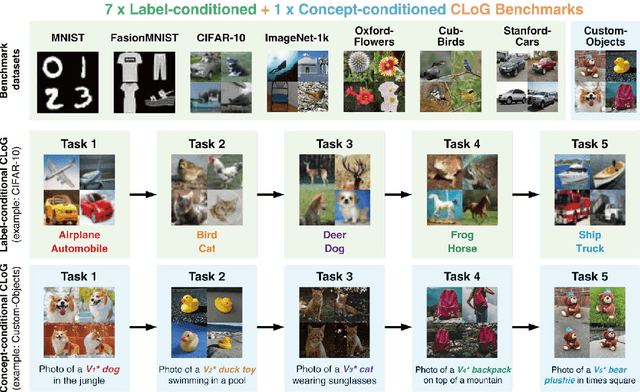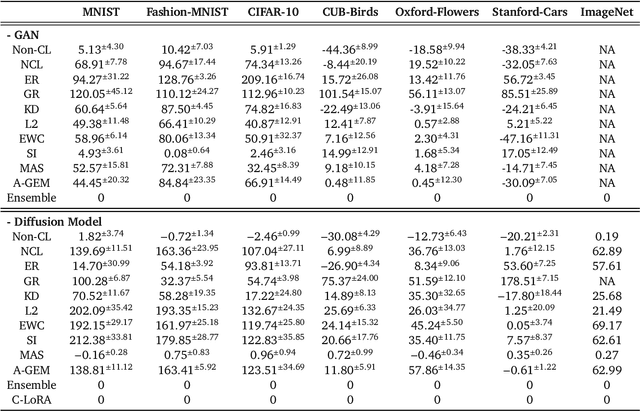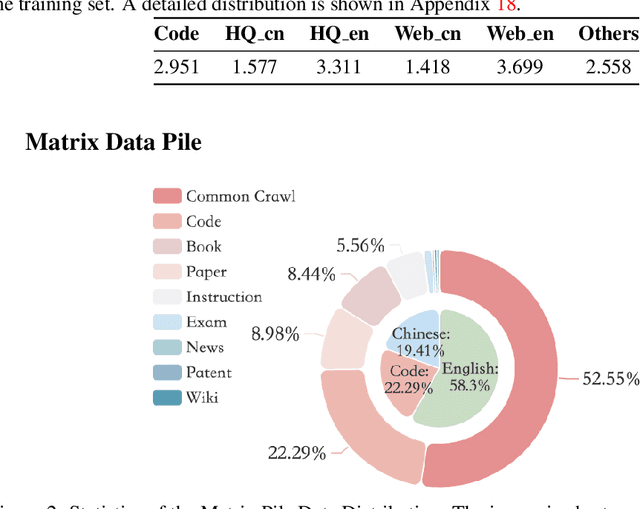Junting Zhou
TinyR1-32B-Preview: Boosting Accuracy with Branch-Merge Distillation
Mar 06, 2025Abstract:The challenge of reducing the size of Large Language Models (LLMs) while maintaining their performance has gained significant attention. However, existing methods, such as model distillation and transfer learning, often fail to achieve high accuracy. To address this limitation, we introduce the Branch-Merge distillation approach, which enhances model compression through two phases: (1) the Branch Phase, where knowledge from a large teacher model is \textit{selectively distilled} into specialized student models via domain-specific supervised fine-tuning (SFT); And (2) the Merge Phase, where these student models are merged to enable cross-domain knowledge transfer and improve generalization. We validate our distillation approach using DeepSeek-R1 as the teacher and DeepSeek-R1-Distill-Qwen-32B as the student. The resulting merged model, TinyR1-32B-Preview, outperforms its counterpart DeepSeek-R1-Distill-Qwen-32B across multiple benchmarks, including Mathematics (+5.5 points), Coding (+4.4 points) and Science (+2.9 points), while achieving near-equal performance to DeepSeek-R1 on AIME 2024. The Branch-Merge distillation approach provides a scalable solution for creating smaller, high-performing LLMs with reduced computational cost and time.
SuperGPQA: Scaling LLM Evaluation across 285 Graduate Disciplines
Feb 20, 2025Abstract:Large language models (LLMs) have demonstrated remarkable proficiency in mainstream academic disciplines such as mathematics, physics, and computer science. However, human knowledge encompasses over 200 specialized disciplines, far exceeding the scope of existing benchmarks. The capabilities of LLMs in many of these specialized fields-particularly in light industry, agriculture, and service-oriented disciplines-remain inadequately evaluated. To address this gap, we present SuperGPQA, a comprehensive benchmark that evaluates graduate-level knowledge and reasoning capabilities across 285 disciplines. Our benchmark employs a novel Human-LLM collaborative filtering mechanism to eliminate trivial or ambiguous questions through iterative refinement based on both LLM responses and expert feedback. Our experimental results reveal significant room for improvement in the performance of current state-of-the-art LLMs across diverse knowledge domains (e.g., the reasoning-focused model DeepSeek-R1 achieved the highest accuracy of 61.82% on SuperGPQA), highlighting the considerable gap between current model capabilities and artificial general intelligence. Additionally, we present comprehensive insights from our management of a large-scale annotation process, involving over 80 expert annotators and an interactive Human-LLM collaborative system, offering valuable methodological guidance for future research initiatives of comparable scope.
CLoG: Benchmarking Continual Learning of Image Generation Models
Jun 07, 2024



Abstract:Continual Learning (CL) poses a significant challenge in Artificial Intelligence, aiming to mirror the human ability to incrementally acquire knowledge and skills. While extensive research has focused on CL within the context of classification tasks, the advent of increasingly powerful generative models necessitates the exploration of Continual Learning of Generative models (CLoG). This paper advocates for shifting the research focus from classification-based CL to CLoG. We systematically identify the unique challenges presented by CLoG compared to traditional classification-based CL. We adapt three types of existing CL methodologies, replay-based, regularization-based, and parameter-isolation-based methods to generative tasks and introduce comprehensive benchmarks for CLoG that feature great diversity and broad task coverage. Our benchmarks and results yield intriguing insights that can be valuable for developing future CLoG methods. Additionally, we will release a codebase designed to facilitate easy benchmarking and experimentation in CLoG publicly at https://github.com/linhaowei1/CLoG. We believe that shifting the research focus to CLoG will benefit the continual learning community and illuminate the path for next-generation AI-generated content (AIGC) in a lifelong learning paradigm.
MAP-Neo: Highly Capable and Transparent Bilingual Large Language Model Series
May 29, 2024



Abstract:Large Language Models (LLMs) have made great strides in recent years to achieve unprecedented performance across different tasks. However, due to commercial interest, the most competitive models like GPT, Gemini, and Claude have been gated behind proprietary interfaces without disclosing the training details. Recently, many institutions have open-sourced several strong LLMs like LLaMA-3, comparable to existing closed-source LLMs. However, only the model's weights are provided with most details (e.g., intermediate checkpoints, pre-training corpus, and training code, etc.) being undisclosed. To improve the transparency of LLMs, the research community has formed to open-source truly open LLMs (e.g., Pythia, Amber, OLMo), where more details (e.g., pre-training corpus and training code) are being provided. These models have greatly advanced the scientific study of these large models including their strengths, weaknesses, biases and risks. However, we observe that the existing truly open LLMs on reasoning, knowledge, and coding tasks are still inferior to existing state-of-the-art LLMs with similar model sizes. To this end, we open-source MAP-Neo, a highly capable and transparent bilingual language model with 7B parameters trained from scratch on 4.5T high-quality tokens. Our MAP-Neo is the first fully open-sourced bilingual LLM with comparable performance compared to existing state-of-the-art LLMs. Moreover, we open-source all details to reproduce our MAP-Neo, where the cleaned pre-training corpus, data cleaning pipeline, checkpoints, and well-optimized training/evaluation framework are provided. Finally, we hope our MAP-Neo will enhance and strengthen the open research community and inspire more innovations and creativities to facilitate the further improvements of LLMs.
MuPT: A Generative Symbolic Music Pretrained Transformer
Apr 10, 2024



Abstract:In this paper, we explore the application of Large Language Models (LLMs) to the pre-training of music. While the prevalent use of MIDI in music modeling is well-established, our findings suggest that LLMs are inherently more compatible with ABC Notation, which aligns more closely with their design and strengths, thereby enhancing the model's performance in musical composition. To address the challenges associated with misaligned measures from different tracks during generation, we propose the development of a Synchronized Multi-Track ABC Notation (SMT-ABC Notation), which aims to preserve coherence across multiple musical tracks. Our contributions include a series of models capable of handling up to 8192 tokens, covering 90% of the symbolic music data in our training set. Furthermore, we explore the implications of the Symbolic Music Scaling Law (SMS Law) on model performance. The results indicate a promising direction for future research in music generation, offering extensive resources for community-led research through our open-source contributions.
COIG-CQIA: Quality is All You Need for Chinese Instruction Fine-tuning
Mar 26, 2024



Abstract:Recently, there have been significant advancements in large language models (LLMs), particularly focused on the English language. These advancements have enabled these LLMs to understand and execute complex instructions with unprecedented accuracy and fluency. However, despite these advancements, there remains a noticeable gap in the development of Chinese instruction tuning. The unique linguistic features and cultural depth of the Chinese language pose challenges for instruction tuning tasks. Existing datasets are either derived from English-centric LLMs or are ill-suited for aligning with the interaction patterns of real-world Chinese users. To bridge this gap, we introduce COIG-CQIA, a high-quality Chinese instruction tuning dataset. Our aim is to build a diverse, wide-ranging instruction-tuning dataset to better align model behavior with human interactions. To this end, we collect a high-quality human-written corpus from various sources on the Chinese Internet, including Q&A communities, Wikis, examinations, and existing NLP datasets. This corpus was rigorously filtered and carefully processed to form the COIG-CQIA dataset. Furthermore, we train models of various scales on different subsets of CQIA, following in-depth evaluation and analyses. The findings from our experiments offer valuable insights for selecting and developing Chinese instruction-tuning datasets. We also find that models trained on CQIA-Subset achieve competitive results in human assessment as well as knowledge and security benchmarks. Data are available at https://huggingface.co/datasets/m-a-p/COIG-CQIA
 Add to Chrome
Add to Chrome Add to Firefox
Add to Firefox Add to Edge
Add to Edge